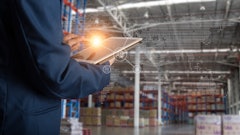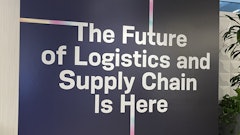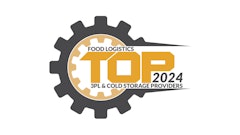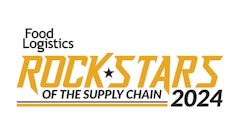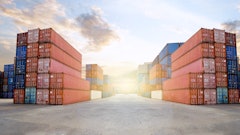
Let’s face it: the forward supply chain reigns. After all, its mission is to build revenues by moving product out the distribution center door to retailers’ shelves and consumers. But what happens when products need to be returned for a variety of reasons?
While the reverse supply chain has been operating ever since people have been trading, it has not received the same focused attention as the forward supply chain relative to characteristic high efficiencies. Although the food and beverage industry far surpasses other industries in efficiently managing reverse logistics, missed opportunities ripe for the picking still exist for the industry. And these ripe opportunities help feed that ever-hungry bottom line.
Reverse logistics is a vastly ignored area with a potential wealth of actionable data, says Chris Ferrell, associate director of Supply Chain Consortium in Raleigh, NC. Only recently were the mechanics involved in returning goods, applying the appropriate credits and product disposition given the moniker reverse logistics. When products in the food industry are damaged, discontinued, out of code or recalled, they need to be removed from the supply chain and returned somewhere for disposition.
“The signature of the food industry is that too many companies go to the extreme side of caution by land-filling almost everything,” says Ferrell.
A study published in 2009 [Reverse Logistics: Returns, Refunds and Recalls] by the Supply Chain Consortium concluded that many companies are not measuring the effectiveness or efficiencies of their returns operations with the same level of attention they employ for their forward logistics. Consequently, they miss opportunities not only to reduce costs, but to discover root causes for returns. Understanding root causes can help direct improvements throughout the supply chain, including engineering, manufacturing, distribution and processes at the retail level.
About 2 percent of products sold are returned through the reverse logistics system, reports Pat Walsh, vice president of industry development for Arlington, VA-based Food Marketing Institute. “The role of reverse logistics professionals is to reduce the quantity of returns and the cost related to handling products that need to be removed from the supply chain for whatever reason.”
Reverse logistics is a complicated process, says Chris O’Brien, vice president of Minneapolis-based C.H. Robinson Worldwide.
“We can offer our clients control over the process through our centralized management of functions starting with the actual return authorization process and ending with value-added financial services like managing accruals, credits and deductions so they can begin the chain of process improvement,” says O’Brien.
Having a process in place is critical for capturing hidden opportunities. “A typical shipper might be delivering to many retailers across multiple DCs,” explains O’Brien. “If there is no process in place for returns or refusals, the shipper could lose control of what will happen with those products and miss opportunities for possible savings. Best-in-class processes ask the right questions about every event. For instance, if transportation is necessary, we can help minimize the return cost and document the details for our clients.”
Shippers have various tolerances for reverse logistics expenses, and some consider the expenses involved as part of the cost of doing business. “Companies who work aggressively with us in customized reverse logistics programs learn root cause analysis, which helps them make the required decisions leading to process improvements,” says O’Brien.
Emerging As A Practice
Reverse logistics represents anywhere from 3 percent to 35 percent of a company’s bottom line, reports Gailen Vick, president and CEO of Reverse Logistics Association (RLA) in Lehi, UT. “But the food industry is in the lower range because it is better at it—it is really in their DNA.”
O’Brien notes “it used to be simply the returns business and returns authorization. The difference now is that the emergence of 3PL providers has initiated the development of systems and processes to make reverse logistics a more robust practice—not just a process housed within supply chain operations.”
C.H. Robinson interfaces with customer service, finance, inventory and QA groups, as cross-functional investment is paramount to driving process improvements, explains O’Brien.
Reverse logistics as a function is gaining interest, says Tom Marcellino, executive vice president of business development for Inmar Inc. in Winston-Salem, NC. “We are even beginning to see individuals with titles like senior director or vice president of reverse logistics as companies assign resources to this area. They recognize that when you apply discipline, management and resources to an issue as significant as unsaleables, the benefits are worth the investment.”
Having an assigned individual or small team charged with managing the process helps providers like Inmar. “A primary point of contact can help us design the right program and acutely measure the performance of that program for our clients,” Marcellino says. “Generally speaking, when companies charge one individual with several responsibilities—including reverse logistics—that individual’s level of interest and attention will not be as focused on reverse logistics as it should be.”
Providers of reverse logistics programs work diligently to minimize the amount of product they dispose in landfills; however, there are still companies using that route. One of the challenges facing the industry is trying to break the mindset of land-filling as the primary method of disposition, notes Ferrell.
“Sending these products to landfills involves a known cost and many companies have gotten the process down so well that it doesn’t feel like it is costing money. Once they break from that mindset, which can be risky and scary, they will discover the opportunities. But this requires leaders who can see the bigger picture.”
Actionable Data Creates Value
Data is absolutely critical because you can’t change what you can’t measure, says Walsh at FMI. “The level of data sophistication varies by company, but data is a critical requirement to provide the metrics related to whether you are making improvements or not. Data needs to be integrated with the other pillars of a reverse logistics management program, namely policies and business handling practices.”
What are people missing about reverse logistics? “One big issue is reason codes are not being captured to identify why the product is being returned—or if they are being captured, they are not really being used,” says Ferrell. “If companies were to apply additional granularity to the process, they would realize there are huge opportunities—other than land-filling—that could be less expensive than trying to get control of those products that have been distributed throughout the country.”
The rich data can be delivered in any number of ways so companies can make the appropriate decisions to take action. For instance, data can provide specific information relative to why one vendor’s merchandise has a higher return rate than others in the same category. “The data also helps retailers and manufacturers understand store compliance regarding product shelf rotation,” says Marcellino. It also helps manage the returns authorization process and ultimately helps manage the proper store crediting procedures retailers have in place.
“A centralized system offers retailers and manufacturers visibility so they can understand why product is being damaged, where it is occurring, what the rate of return is and where to focus their efforts to improve the process,” he adds.
Inmar delivers the data through two Web-based portal applications—one designed for food manufacturers and one tailored for food retailers and distributors.
“Generally, retailers are interested in understanding returns by store and by supplier,” explains Marcellino. “So they need to track at the UPC and store levels. They can see if there is a supervision problem within certain stores and they can see if certain stores are having higher rates of returns than others. They can then discover why this is so.”
The data portal also allows retailers to manage, identify, and track store crediting information and handling fee transactions at the UPC and/or at the store level for remuneration for returns.
As of 2008, the food and grocery industry rate of returns as a percentage of sales was between 1.2 percent and 1.8 percent. Although this rate has been fairly constant over the last few years, manufacturers and retailers continue to manage unsaleables, notes Marcellino. “Returns-related information captured through the reclamation process provides trading partners a basis for collaboration focused on root-cause identification and mitigation,” he says.
In addition to return authorization management, C.H. Robinson offers its clients the ability to track a number of metrics, depending on just how much data clients wish to monitor. Data can include returns and refusals by shipment, by SKU, by business unit, by receiver, and by shipper.
“We also conduct reason code analysis and product disposition summaries for our clients,” says O’Brien.
A faulty returns process can be costly and cause unnecessary inefficiencies. “Centralized reclamation provides the industry an efficient means for removing unsaleables product from stores and DCs, and is an excellent infrastructure to support product recalls and withdrawals,” says Marcellino.
Furthermore, with the increase in the number of private label products, retailers need to start thinking more like manufacturers and they need to study what is causing damages. “They can make better process and packaging decisions for their private label products by collecting and acting on the data,” Marcellino says.
Management Through Data Centralization
Supply chain visibility is critically important for process efficiencies, no matter what the industry. “We are a veritable clearing house of data informing our clients’ process improvement decisions,” says O’Brien at C.H. Robinson. In addition to data relating to product, the company can also advise clients whether there was a customer service error or warehouse error.
The primary best practice is to offer clients the ability to customize their reason codes because each client has a different set of circumstances that result in returns or refusals, notes O’Brien.
“We have consulted with our clients on packaging changes and different ways to load trailers, and our people conduct root-cause analyses with shippers to identify some of the trends driving damage. But it is not just about damages anymore. We are looking more closely at code date issues, discontinued products, and operational practices at both the shipper and receiver levels to create order exceptions and influence returns policy,” says O’Brien.
Inmar’s analysts use data management programs that provide clients with focused visibility. “Clients can view their information online through our Web-based application portal,” Marcellino says. “Our centralized returns facilities enhance visibility so clients can reduce damaged and unsaleable merchandise.”
With its network of 33 returns facilities, Inmar helps clients minimize the distance, time, and expense associated with transporting returned merchandise. Inmar’s holistic approach can affect other areas of the supply chain, including distribution, storage, packaging, palletizing and transportation.
The food industry works within very low margins, reminds Vick at RLA. “So if companies can resurrect even just 1 percent to the bottom line, the CEO would be considered a hero. Unfortunately for some companies, return logistics is not a big enough problem for the CEO because he is worried about saving a nickel on forward logistics simply because, in many cases, reverse logistics doesn’t bubble up. The reason is because CEOs don’t have anyone high enough in their management teams who are managing reverse logistics.”
Clearly, the opportunities hidden in the reverse logistics process are worth investigating from a cost savings perspective as well as from a process improvement perspective. What might appear to be low percentage increases that can be added to the bottom line through customized reverse logistics programs are beginning to look more enticing. For instance, Ferrell explains that identifying a packaging flaw can increase that percentage increase by a factor of 100. “Or you can increase that by a factor of 1,000 if you can identify a flaw that extends beyond that one product into multiple products,” he says.
OPTIMIZING THE RETURNS CHAIN
Companies measuring data collected from their reverse logistics programs can gain a deeper understanding of what is causing returns and how to minimize them by taking the appropriate course of action. They can also reap significant savings by optimizing the returns supply chain, similar to efficiencies achieved by their forward supply chains. Here are a few examples.
Identifying returns problems: Renkitt Benckiser—the manufacturer of French’s products—has Inmar manage its returns process. The company uses the data provided by Inmar to identify recurring problems.
“We monitor the quantity of items returning back through the reverse logistics program to see if any specific item is producing more problems than other items,” says Joe Genda, director of credit for the Parsippany, NJ-based company.
The data allows Genda and his team to know where to begin to discover what is causing these returns. “The data provided allows us to zero in on the problem items and fix the cause of the problem. Knowing you have a problem is one thing—but knowing where to start to fix the problem is definitely a big benefit to having a reverse logistics program.”
Genda reports that Renkitt Benckiser’s returns average is lower than the industry average, and he attributes this achievement to having Inmar manage the program.
Closed-loop system: In 2000, Kellogg Co. implemented its Closed-Loop Returns Management System with the help of Inmar. This closed-loop supply chain combines traditional forward supply-chain activities with returns management. The Battle Creek, MI-based company wanted to reduce the amount of unsaleables and knew that such a program would also reduce costs while improving process efficiencies and overall satisfaction at the customer and consumer levels.
Kellogg’s not only collected data—it designed the closed-loop to be an actionable model embraced by all functional areas so the data presents information that is measured. It then closes the loop with accountability from the various functional areas involved, including customer service, distribution centers, logistics, marketing, packaging, remarketing and returns management, research, retail sales, quality and packaging suppliers.
The company’s unsaleables team was able to influence management by effectively explaining the issues involved from a financial perspective, highlighting all decision options in dollars as a return on investment. Thus, by speaking this common language and involving senior management and finance in the decision-making process, they were able to influence the decision-makers and secure the necessary funds for the program. —A.T.









